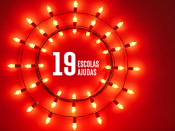Por Kora Muzic (Center for Astrophysics and Gravitation, FCUL).
Massive young star clusters are fundamental building blocks of galaxies, and the most abundant reservoirs of newly born stars in the Milky Way. Their populations can span more than four orders of magnitude in mass, from the most massive stars with several tens of solar masses, down to brown dwarfs - substellar objects with masses that, at the low-mass end, overlap with those of giant exoplanets. In this talk, I will present a study of stellar and substellar population in the Rosette Nebula and the young massive cluster NGC 2244 at its centre, including an application of the Probabilistic Random Forest algorithm to study the stellar population, and spectroscopy efforts that yielded the first confirmed brown dwarfs at distances beyond 1 kpc.
Short bio: Kora Muzic obtained her PhD in 2008 at the University of Cologne in Germany. Afterwards, she held postdoctoral positions at the University of Toronto (Canada), University Diego Portales (Chile), and the fellowship of the European Southern Observatory in Chile. In 2017, she joined the CENTRA team at FCUL, working mainly on topics related to low-mass star and brown dwarf formation.

















